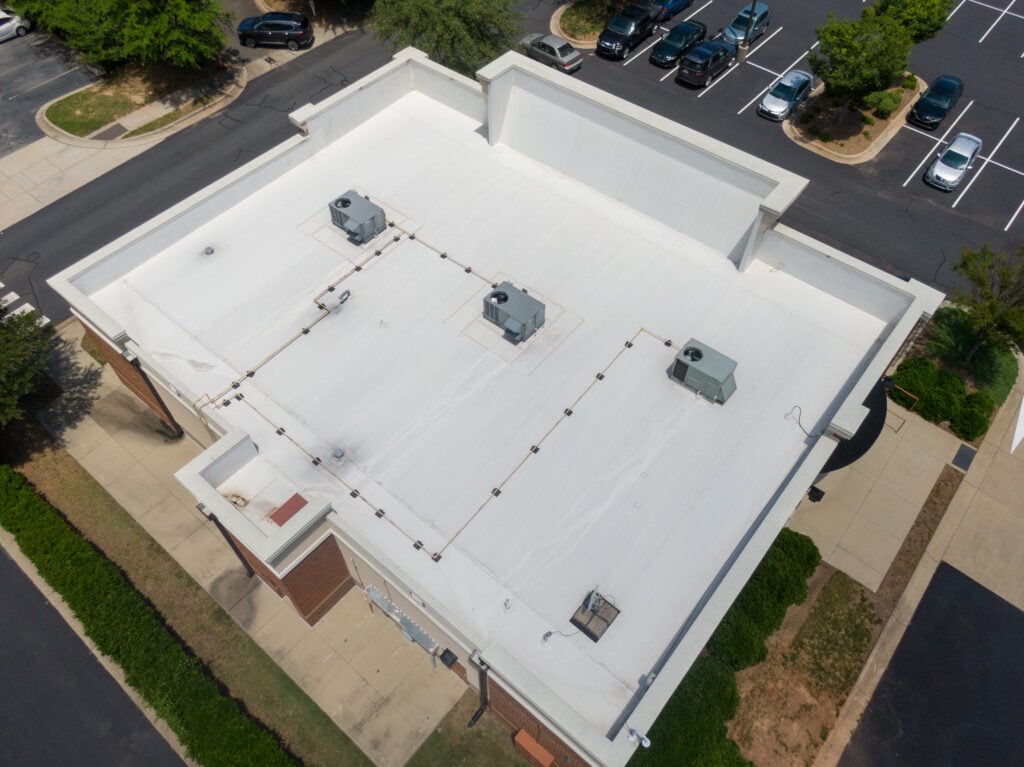

How Flat Roof Replacement Works On Commercial Roofs
Posted August 7th, 2025 | 6 min. Read
Commercial flat roofs take a beating. From intense UV rays to pooling water and severe weather, these roofing systems work hard to protect your business investment. When repairs aren’t enough anymore, flat roof replacement becomes essential for maintaining your building’s integrity and protecting your operations.
Understanding the flat roof replacement process helps you make informed decisions about your commercial property. This comprehensive guide walks you through everything you need to know about replacing your commercial flat roof, from recognizing when it’s time for replacement to selecting the right materials and working with qualified contractors.
Here’s what we’ll cover in this detailed breakdown:
- When to replace your commercial flat roof
- The complete flat roof replacement process
- Preparing your business for roof replacement
- Cost factors and budgeting
🤔 When to Replace Your Commercial Flat Roof

Recognizing when your commercial flat roof needs replacement rather than repair can save you thousands in emergency fixes and business disruption. Several clear indicators signal that flat roof replacement is your best option.
Age is often the primary factor. Most commercial flat roofs last 15-30 years, depending on the material and maintenance history. If your roof is approaching or has exceeded its expected lifespan, replacement becomes more cost-effective than continued repairs.
Extensive water damage presents another clear sign. When water infiltration affects large portions of your roof or has compromised the building’s structure, repairs won’t address the underlying deterioration. Persistent leaks that return after multiple repair attempts often indicate systemic failure.
Surface deterioration also signals replacement needs. This includes widespread cracking, blistering, or membrane separation across significant roof areas. When these issues cover more than 30% of your roof surface, replacement typically offers better long-term value.
Types of Commercial Flat Roofing Materials
Commercial flat roof replacement offers several material options, each with distinct advantages for different building types and climates. Understanding these choices helps you select the best system for your specific needs.
- Single-Ply Membrane Systems: TPO, EPDM, and PVC are popular options for energy efficiency, durability, and waterproofing. TPO reflects heat and reduces cooling costs, EPDM excels in temperature extremes, and PVC offers top-tier chemical resistance for harsh environments.
- Modified Bitumen Systems: Combining built-up roofing with polymer technology, these systems feature UV-resistant layers and can be installed using torch application, adhesives, or self-adhering sheets.
- Built-Up Roofing (BUR): Made of asphalt layers and reinforcing fabrics topped with gravel or mineral surfaces, BUR systems are durable and customizable but require labor-intensive installation.
✅ 7 Step Flat Roof Replacement Process

Understanding the flat roof replacement process helps you prepare your business and set appropriate expectations. Professional commercial roofing contractors follow systematic approaches to ensure quality results.
1. Initial Inspection and Assessment
The replacement process begins with comprehensive roof evaluation. Contractors examine the existing roof structure, identify problem areas, and assess the building’s overall condition. This inspection determines whether the roof deck needs repairs or reinforcement before installing new roofing materials.
2. Material Selection and Project Planning
Based on the assessment, contractors help you select appropriate roofing materials considering your budget, building requirements, and local climate conditions. Project planning includes scheduling, material ordering, and coordinating with your business operations to minimize disruption.
3. Permits and Code Compliance
Commercial roof replacement typically requires building permits and must comply with local building codes. Professional contractors handle permit applications and ensure all work meets current regulations and standards.
4. Roof Preparation and Tear-Off
The replacement begins with complete removal of existing roofing materials down to the structural deck. Contractors inspect and repair any deck damage, ensuring a solid foundation for the new roofing system. Proper disposal of old materials follows environmental regulations.
5. Insulation and Vapor Barrier Installation
New insulation installation improves energy efficiency and meets current building codes. Contractors install vapor barriers as needed to prevent moisture infiltration and condensation issues within the roof system.
6. New Roofing System Installation
The new flat roof installation follows manufacturer specifications and industry best practices. This includes proper membrane installation, seam sealing, and flashing details around roof penetrations, drains, and building perimeters.
7. Quality Control and Final Inspection
Professional contractors conduct thorough quality control checks throughout installation and perform final inspections to ensure proper installation. Many provide detailed documentation and warranty information upon project completion.
👉 Preparing Your Business for Roof Replacement
Commercial flat roof replacement requires careful planning to minimize business disruption while ensuring worker and occupant safety. Proper preparation makes the process smoother for everyone involved.
Operational Planning
Coordinate with your roofing contractor to establish work schedules that minimize impact on your business operations. Consider factors like noise levels, equipment access, and potential temporary relocations of sensitive operations or inventory.
Communicate with employees, customers, and tenants about the project timeline and any temporary inconveniences. Clear communication helps manage expectations and maintains positive relationships during the construction period.
Safety Preparations
Commercial roof replacement involves significant safety considerations. Professional contractors implement comprehensive safety protocols, but building occupants should understand and follow any special safety requirements during construction.
Ensure clear access routes for contractor equipment and materials. Remove or relocate any items that could interfere with construction activities or become damaged during the project.
Documentation and Insurance
Review your insurance coverage and notify your carrier about the planned roof replacement. Many policies have specific requirements for construction activities that could affect coverage.
Document the existing roof condition with photographs before work begins. This documentation can be valuable for insurance purposes and helps track project progress.
💵 Cost Factors and Budgeting

Commercial flat roof replacement costs vary significantly based on multiple factors. Understanding these variables helps you budget appropriately and make informed decisions about your roofing investment.
Size and Complexity
Roof size directly impacts material and labor costs, but larger roofs often benefit from economies of scale. Complex roof configurations with multiple levels, penetrations, or unique architectural features increase installation complexity and costs.
Material Selection
Roofing material choice significantly affects project costs. Premium materials like PVC or high-performance modified bitumen systems cost more initially but may provide better long-term value through durability and energy savings.
Structural Requirements
Buildings requiring deck repairs, structural reinforcement, or extensive insulation upgrades will see higher project costs. These improvements, while adding to initial expenses, ensure proper roof performance and building code compliance.
Market Conditions
Local market conditions, seasonal demand, and material availability can influence pricing. Planning your project during contractors’ slower seasons may provide cost advantages.
Professional contractors provide detailed estimates that break down all project costs, helping you understand where your investment goes and identify potential areas for cost optimization.
👨🔧 Trust the Experts for Your Commercial Roofing Needs
When it comes to flat roof replacement, choosing the right team can make all the difference. At Certified Roofing Solutions, our years of experience, GAF Master Elite certification, and commitment to quality set us apart as leaders in commercial roofing. We specialize in delivering durable, efficient, and cost-effective roofing solutions tailored to your building’s unique needs.
Don’t leave the integrity of your business to chance—trust the experts who prioritize your investment every step of the way. Contact us today for a free estimate and let us help you protect your business with the reliable roofing solutions you deserve!

